William James Nancarrow was born on 26th March, 1918 in Subiaco, at Nurse Lloyd’s Private Hospital in Coolgardie Street. He had several nicknames, including Blue, Bluey, Bill, and finally, Nono. We will refer to him today as Blue, his most popular name.
[Photo – Nana and Pop Nancarrow – dressed to a family wedding.]
Blue was the firstborn son of William George (Pop) Nancarrow and Ivy Sibyl (Ridley)
Although they lived and married in Mullewa, Ivy (long known as Nana Nancarrow) came to Perth for Bluey’s birth.
Blue’s older sister, Daphne Sibyl, was born 28 May, 1915, in Fremantle.
His convict forebears.
He was David Sivewright, a convict who made his own way in the world. She was Lillias Auld, a sponsored Scottish bride.
One of their daughters, Margaret, married Robert Ridley in 1896 in Nannine. Called “Maggie”, but fondly known to us as Grandma Ridley, they built a successful business career in the mid-West.
Being in the railways was unsettling for families.
Blue’s Dad, “Pop” Nancarrow was employed by the W.A. Government Railways (W.A.G.R.) and as the years went by, his different postings had a major impact on Blue’s life and the large family.
The railways offered a secure career, but you had to be prepared to move, family and all, from one small country town to another. Nana and Pop moved all around the mid-West with the W.A.G.R.; from Mullewa, to Day Dawn, Geraldton and Caron, Mukinbudin, Collie, and other small towns.
One brother (Teddy) went to work for the Midland Railways WA (M.R.W.A.); his final posting was at Walkaway and Dad’s sister Phyllis married into the Midland Railway company, too.
Nana Nancarrow and Pop lived in Mullewa until 1919, when he became a porter at Day Dawn station. In 1922, he was promoted, and transferred to Geraldton as a guard. In-between, the family had lived in Yalgoo (1920), and Midland (1921). Blue started school in Geraldton in 1923, just before he turned six.
Meanwhile, back in Mullewa
The family moved from Geraldton to Caron in 1925, and Daphne went back to Mullewa to live with her grandparents, at the age of 10. Grandma Ridley was a beacon of stability in the life of her grandchildren, which often beckoned them home and she was still in their lives, until the 1950’s, living in Maylands.
Although Grandma Ridley (Maggie Sivewright) was not well accepted into the society circles of the day, at the age of 15, Daphne made her debut on 13th September 1930, at a Grand Hospital Ball in Yalgoo. A fundraising charity event, the ladies were all reported as being beautifully gowned, apart from one. “Miss J. Lee, fawn lace frock, with uneven hem,” was reported in all the social news of the day.
Amongst the crowd were Mr. & Mrs. Don Beaton and three children, of Thundelarra Station. Before Miss Gwen Clarke was crowned the Queen of the Night, the right to place the crown upon her head was knocked down to the highest bidder, Mr. Don Beaton Jnr. They were in fact our cousins, although it would be a few years before Isobel (nee Beaton) would meet Blue.
The major move from Geraldton to Caron and on to Midland
The family moved to Caron in 1925, and lived there until 1928. During this time, there were enough children to guarantee the viability of the primary school at Caron.
By 1928, aged 10, Blue had been joined by
*Edward George (Teddy), born 6th November 1919,
*Phyllis Muriel, (Phil) born 16 May 1922,
*John (Jack), born 14 Dec 1924, and
*Bernard Ernest (Rusty), born 23 January, 1927.
For many years, Blue went to Caron school reunions and his old school teacher (Miss. Wilma Peacock, who married Bill Dawson the Stationmaster at Caron and also at Mukinbudin) used to come along too.
[Photo – Invitation to a Caron School Reunion – 1984]
We know he did attend this one in February, 1984.
Railway families were the backbone of the mid-West.
In 1928, with five children, and Nana Nancarrow pregnant with Dot, the family moved to Midland. Blue, Teddy and Phil continued their schooling at Midland Primary School, while Jack and Rusty were still at home. Dorothy Mae (Dot) was born in Midland, on 23rd August, 1928.
A baby sister, Marjorie Emma, was born on 13th October 1929, but her life was short. She was buried on 3rd January, 1930, when Blue was almost twelve. It affected him deeply, and he never forgot her.
Within the same year, Blue’s sister Betty Edith was born on 27 December 1930, in Midland and the family continued living together in Elvire Street. On Blue’s 14th birthday, in 1932, he left school and enrolled at the Midland Junction Metalwork Centre, for a year. He completed the year, and on May 3, 1933, he obtained his endorsement and work reference from Mr. L. Brown. It attests to his diligence and reliability over the previous year, and strongly recommended him to any future employer. The first of many such references for Blue Nancarrow.
There were big changes coming up for Blue. In March, 1933, he went droving on Gabyon Station at Yalgoo. At age 15, his pay was 10/- per week and keep. That’s a yearly wage of $51,000 today.
After Midland, the move to Muckinbudin.
A huge family move took place in June 1933. The whole brood packed up and went to Muckinbudin. Blue left the Mullewa district, where he had been working, and living with Grandma Ridley on and off, and came home, although Daphne stayed behind.
Blue had just turned 15, and five of the family were at school in Muckinbudin. Teddy (13) Phyllis (11) Jack (8) Rusty (6) and Dorothy (5). Betty was a toddler aged 2 and a half, and Thelma Joy (Sally) born 28th February, 1933, was three months old.
For many years, Lesley and Richard thought there was an extra Aunt there. Very confusing, with all the extra nicknames used in the family.
On 27th June, 1934, a brother, Donald, was born, but only survived two days. Eighteen months later, Blue’s youngest sister, Rae was born in Subiaco, on 18th January 1936. It was always a laugh when Blue would say to Rae “do you remember……..” about the days in Mucka, and she could never get it through his head that she wasn’t born until after he actually left home, again. Rae was born at K.E.M.H in Subiaco; Nana Nancarrow made the journey from Mukinbudin for the confinement and birth.
She is the last of Blue’s eleven brothers and sisters born to Nana (Ivy) and Pop (William George) Nancarrow, who married on September 17, 1917 in Mullewa.
Blue’s early working life
Blue’s first job in Muckinbudin, in 1933, was ploughing with a horse for Mr. J. Ferguson, for ten bob a week. He lasted a month. It was in Muckinbudin that his interest in competitive sport really began to shine. He took up cycling, football, and cricket. He played Country Week cricket for Lake Brown for three years, while he lived and worked in the district. In April, 1936 aged barely 18, Blue was awarded a trophy for his cycling exploits in Mukinbudin – along with his friend Jimmy Stewart.
During those three years, he often had to ride his bike from one town to another, or one farm to another. Blue got a wealth of experience on the land, and after a brief holiday in Perth, returned to country life via Wokalup, Narrogin, Spencer’s Brook, Wongan Hills, and back to Mullewa. He spent a couple of weeks with Uncle Ned Ridley, and then left for Cue. By jumping a train. It was common practice for itinerants looking for work to jump a mixed goods train. It was Blue’s father’s job to get them off!
Leaving Muckinbudin for the final time.
In 1937, he left Mucka for the final time, to work in Caron on Reid’s farm. They helped him get a job with the Farrell family at Perenjori; he spent a season there seeding, and after a few months Blue went to live with Grandma and Granddad Ridley, who had moved from Mullewa to Cue.
It was hard, physical labour. Dry blowing with Bob (Granddad) Ridley. Shovelling sand at vats near the Cue recreational grounds. He built a wash-house for George Michael, and his spare time was taken up with cycling, and football, where he was written up in the local paper as “Nancarrow has shown some improvement over his usual game”. He loved cricket and had a career highest score of 78 not out.
A self-reliant station hand, aged 19.
From here, he mustered and drove the sheep to the shearing sheds at Mt. Gould, and he saw the shearing season right through in that year of 1937/1938. The station manager delivered rations once a week. Blue rode the fences daily, to check two windmills, and the water troughs for four paddocks. Occasionally he would ride over to another outcamp on a neighbouring property, to exchange books and get the news, or maybe receive a visitor of his own. At the end of his term, he returned to Cue, and spent time prospecting and dry blowing for gold with Granddad Ridley. He says they didn’t strike it rich!
Moving to Big Bell, to find work
But not only because he was a skilled metalworker.
Before arriving in Big Bell, Blue obtained a personal reference from the local Muckinbudin JP, E. B White, (23rd January 1939).
It clearly says he has known Blue for the past six years and recommends him for any position where hard work and a willingness to learn are required.
His sporting ability was a key part of him getting his job – because the mine management was keen to see the Big Bell Football Team strengthened and go up against Cue, Reedys and Mt Magnet. He and four mates had all been to football training, two nights a week, and were hired in May 1939. They got to live in the single men’s quarters, which was much better than being camped in the creek bed.
Their first job was to fence the mine site and tailings dam – about two miles of fencing. After the fence was complete, Blue started three months of surface labouring. His next move was to be shifted to Mill Maintenance Crew, where he started to study and became an apprentice mechanic.
Off to War.
In 1940, Blue enlisted in the Reserves, with his good friend Jimmy Price from Coodardy Station, at Big Bell.
They were both called up on the same day, 10th July 1941.
[Photo – Blue Nancarrow and Jimmy Price – both called up in 1941]
[Photo – Isobel (Beaton) and William (Blue) Nancarrow – married in Perth 8th august 1941]
Blue and Isobel, whom he met when she was working in the canteen on the mine, were married on August 8, 1941.
It was a short honeymoon: they were married at 5:00pm on Friday in St. George’s Cathedral and Blue left on a troop train from Perth Central Station for Adelaide at 12:00noon the next day.
Nana Nancarrow came down from Mukinbudin with Rae – then a little girl of five – to see him off.
Rae remembers meeting them, and Isobel wearing a hat. Nana went back to Mukinbudin, and Isobel went to stay with her sister, Marian until she could sail to Adelaide under full wartime conditions, to be Blue’s wife.
What did you do in the War, Daddy?
Blue completed his rookie training at Pearce Air Force base. First posted to Adelaide, and then sent to Melbourne to study Aircraft Fitting, Isobel followed him from station to station, almost like a railway wife. With his metal working skills deeming him essential services, Blue could not be deployed overseas as were Jack and Rusty, and that was a great relief to Isobel.
The target, battle cruiser, USS Chicago with a company of 700, was fired upon in the harbour. The discovery of the sunken third and final sub, in 2005, made him a proud and happy man.
It solved a 75yo mystery, and confirmed his work on those bombers as a crucial part in preventing more attacks on ships inside Sydney Harbour.
Later, Blue was sent to Adelaide’s School of Mines, to study turning and engineering, and Isobel worked in a munitions factory, helping assemble gas masks. Once qualified as a fitter and turner, he was sent to Geraldton, where he unfortunately broke his knee while riding a horse. (Bluey’s Knee – There is a whole other story about that, as well.) Upon recovery, and after Lesley was born in Geraldton, on December 26th, 1943, he was transferred back to Pearce.
Back to Big Bell and the birth of a son.
Immediately put to work on some difficult engineering problems in the mill, Blue soon had the mill room operational again. Then he went to the machine shop to complete his training as a fitting engineer and turner. Passing all his exams with flying colours, a promotion to staff meant Blue moved his family up to staff housing on the mine, and he became the leading-hand fitter in the mill.
Apart from his four and a half years in the R.A.A.F, Blue worked on the Big Bell mine, from 19th May 1939 until 24 August 1954. A fifteen year time span. He left primarily because the mine was coming to the end of its life, and he needed a new career. Long disenchanted with living in the goldfields, Isobel pressed her case of future schooling for Lesley and Richard as being a concern. She refused to move to Kalgoorlie.
On to Perth, and the Snowy Mountains
The family went to stay with his sister Dorothy, in Broad Avenue, Belmont, and Blue quickly found employment with Cumming Smith Superphosphate, in Bassendean. His Driver’s License (dated 21st September 1954) lists them as his employer, and on 1st October 1954, he and Isobel bought their house at 15 Hudson Street, Bayswater. It was then listed as Lot 701.
Jack and Rusty were working on the Snowy Scheme, and Blue got a telegram from Rusty: “Catch the first plane. Money for shit” and so, he went. Notwithstanding he was leaving Isobel, Lesley and Richard behind in an unfinished house.
The nearest town was Cabramurra, half way between Tumut and Cooma.
Drilling towards what would become the Eucumbene tunnel opening at Junction Shaft, the Nancarrow brothers drove their teams hard. The miners broke the world hard rock tunnelling record, by advancing a 24’ diameter hard rock tunnel 461’ in six days. Each of the crew’s teams received a miniature jack-hammer, and a letter of confirmation dated 30th October 1955. A year after starting from the Eucumbene Portal end, Blue’s promotion to leading hand led to a transfer to Junction Shaft and higher wages.
Educating Children
In about June 1956, Isobel, Lesley and Richard joined him to live in the company town of Happy Jack, close to the Junction Shaft work face. He received his Certificate of Competency as a Power Hoist Driver in July. That winter saw the worst blizzards for over fifty years. Later that year Nana and Pop Nancarrow, and cousin Dulcie Cushing, come to visit Jack and Rusty and stay in Happy Jack for a holiday.
The family moved to Cooma in early 1957, so Lesley could attend High School, and Blue went back into the single men’s quarters at Eucumbene Portal. Now working on concreting the tunnel he help drill, he became a Drive In Drive Out Dad once a fortnight.
In April 1958, Blue resigned, and the family returned to Perth. Lesley went to Midland High School for part of a year, and then to Perth Commercial College. Richard started at Hillcrest Primary School.
Back to the Snowy in 1958
Within three months, Blue returned to the Snowy, and took four of his mates from Cumming Smith Mount Lyall with him. They included Billy Woods and John Grieve, who met and married his future wife Kaye in Tumut. They became life-long friends of Blue.
The highest rank available to non-Americans, all three Nancarrow brothers became Shift Supervisors. Between them, they ran their tunnel, 24/7.
The family was still in Perth, with Blue living the miner’s single life.
Isobel, Lesley and Richard moved from Perth to Tumut. Blue spent several months in hospital and lost part of a toe.
Blue went back to work, and in Dec 1959, he received a salary increase to £58.10.0 pw. That is equivalent of $89,960 a year, today. Somewhat better than the average wage of the day: $26,467 per year.
Given the option of signing on for another contract, or resigning, Blue (or maybe Isobel) decided five years in the Snowy Tunnels was enough, and he finished with K.P.M.R. on 23rd May 1960.
He left every position with reference to his outstanding qualities, as an employee, a worker, and a leader of men. Suffice to say, Isobel was not always of the same mind.
From Tumut, the family moved to the South Coast of N.S.W, and lived in three or four different houses, over the next 18 months, until they decided to return permanently to Perth.
Vickers Hoskins – an Engineer without peer.
In 1962, Blue took up his position with Vickers Hoskins which was to last until he had to accept mandatory retirement at 65, on 26th March 1983.
He had a stellar career with them, helping engineer amazing mining equipment and shipping machinery.
On a scrap of paper Lesley found a list of twenty three major projects for which he was primarily responsible.
Not only was he building them in the workshops, he often went into the field to supervise their installation and commissioning.
His achievements include the first cranes at Fremantle for handling bulk containers.
He helped design and build unique machinery for both gold and iron ore production. He was without peer, in his day.
[Photo Blue’s list of 23 major projects for Vicker’s Hoskins]
Blue’s recovery from an almost fatal accident.
In 1971, Isobel and Blue took up residence in a caravan in the Sorrento Caravan Park, so Isobel could be near the sea. Lesley moved into Hudson Street, on her own, and her three children came back to live with her in that house in 1972.
In 1973, while working on Fremantle Wharf, Blue suffered a severe neck injury. Hit on the head with a hammer, he then became involved in a traffic accident on the way back to Vickers Hoskins. Blue was in hospital for months, and not expected to ever walk again.
He had several major operations, including a successful laminectomy. However, Blue and Isobel endured the kind of battle with insurance companies, for ongoing financial assistance, you hear about on television.
Dr. Ross Robinson, the neurologist, was a stalwart supporter especially for Isobel.
Getting back to work
Lesley and the children moved into a State Housing Commission flat in Lockridge. Richard and Sandra, along with Sean and Anna, came to live at Hudson Street, which they shared with Isobel and Blue. When Neil was born in August 1976, Isobel and Blue took up residence again in the caravan. But this time, in their own back yard.
After twelve months of rehabilitation, Blue returned to Vickers Hoskins, although Sandra had to drive him to and from work every day.
Still capable of putting in a good day’s work, although not able to drive, his love of engineering and big project metal work never diminished. His retirement on March 26, 1983 was mandatory and age based.
Toodyay to Glendalough and Stoneville
[Photo – Robin McKay and Blue Nancarrow got several write-ups in the Press for their work] </p>
Never one to be idle, Blue accepted an offer for a “married couple” on Robin and Karen McKay’s Farm in Toodyay, in September 1985. It’s fair to say Isobel hated it, being so isolated and far out of town.
Blue loved it. He was in his element, among all the machinery and metal work.
He and Robin drove all over W.A. collecting, restoring, and showing old stationary engines.
Isobel left Toodyay to help care for Nana Nancarrow in Cloverdale, for a couple of months, until she died on ANZAC Day, in 1988.
It was their family home in Homewood Street. “Rusty” bought it for them, and he, Nana, and Pop all completed their lives in that home.
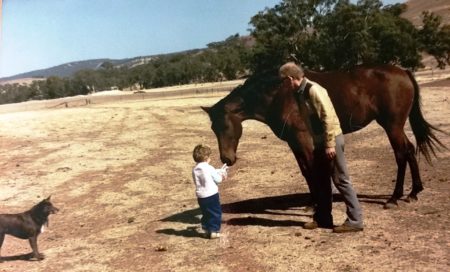
Isobel returned to Toodyay; over the years many grandchildren came to visit them, and she and Blue left “The Farm”, in September 1992.
Isobel’s ongoing kindness to Blue
Isobel and Blue lived under the same roof, but separated, for about ten years, in Toodyay and in Glendalough.
Blue moved to Stoneville in 1992, and Isobel continued happily living on her own.
With her cat, when she had the right place to live. They were on friendly terms. Well, more that Isobel was friendly and Blue still besotted with her. He also became besotted with Splinter – his very own cat. At the age of 88.
They did this for more years than Lesley can remember.
Even after he came to Stoneville and could no longer drive, Lesley would put him on the bus in Mundaring on a Saturday. He would make his way down to the city for his overnight stay.
It is a measure of Isobel’s kindness to Lesley, to allow her some respite, that she let Blue regularly stay overnight. He would stay on a Saturday in her various residences around the inner suburbs, to play cards on Sunday. Lesley would collect him the next day. This included Henry House on Gt. Eastern Highway, her HomesWest unit virtually next door, and her unit in Beatty Avenue.
Happy Families at Beatty Avenue, in East Victoria Park.
Blue began living with Lesley and Robbie after leaving Toodyay, in 1992. It was a couple of years after Robbie had stopped working, due to his emphysema.
They continued to live in Stoneville, after Robbie’s died on 9th June 2002. Isobel was living at 51A Beatty Avenue, having moved in from Archbishop Goody Hostel on 16th April 2007. Lesley and Blue came to live next door to her, on 11th May, 2008.
Warren, Lisa, and Gordon, and other family friends, like Stuart and Jane and Ian, made sure Blue enjoyed his birthdays whether Lesley was at home or not.
Isobel proved to be a very willing participant.
Isobel would often cook a Sunday roast for them to share. Nevertheless, Lesley did sometimes bewail having to walk the “38th Parallel” to maintain the demilitarised zone.
Blue was as besotted with Isobel as ever. In November 2013, Isobel returned to Archbishop Goody, now physically frail, but remaining highly sound of mind.
Mandurah Move and into Banksia Park.
Lesley and Blue started planning their Mandurah Move on April 7, 2014, two years after Blue first refused to move from Beatty Avenue. With a bathroom and kitchen to renovate, it was six weeks before their last dinner at Beatty Ave, on 18th May 2014. It took another two weeks to finish the move, and Lesley drove 6,956kms in those weeks.
Tragically, Douglas Hope, Lesley’s first husband, died on 16th May, 2014. In the midst of helping Lesley and Blue move, Warren and his sisters had to arrange his funeral, for a few days later.
By Christmas, 2014, Blue’s rapid onset dementia (at age 96) made it impossible for Lesley to care for him full time. After an ACAT Assessment in January 2015 and some respite care, Blue moved into long term residential care, at Aegis Banksia Park on 16th March, 2015. He celebrated his 97th birthday there, and two more after that.
Isobel also moved to Banksia Park, but her health unexpectedly declined. She was only in residence there for a few weeks, before she passed away on 28th August, 2015, aged 94. Still reading Dickens and murder mysteries.
Caring for Blue’s emotional well being
Blue loved her until his dying day, and we never told him Mum had passed away. If he asked about her, we said she was at Archbishop Goody, helping care for his sister, Dorothy. Indeed, this was actually true.
Using Facebook, we kept most friends of the family up to date with his interaction and awareness, which varied a great deal.
He was in excellent spirits and good humour on Christmas Day, 2017. He especially enjoyed his Crème de Menthe after dinner. The family is deeply grateful for the excellent care and compassion always shown to Blue by his nursing staff.
2018 – January 16 – Blue passed quietly in his sleep at Banksia Park Nursing Home, in Orelia, Western Australia.


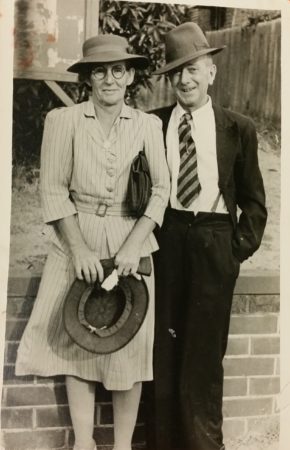

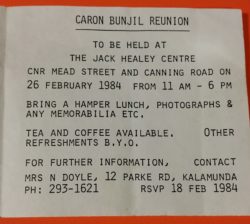
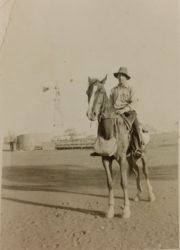

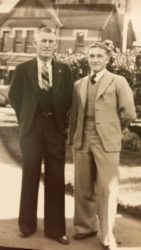
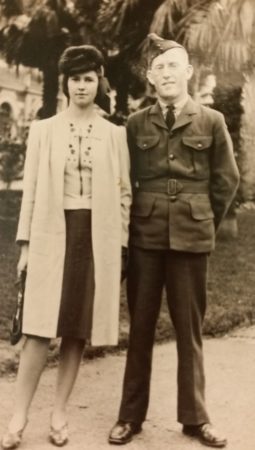
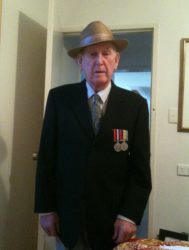
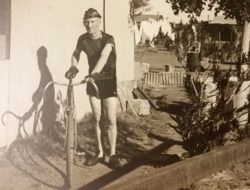
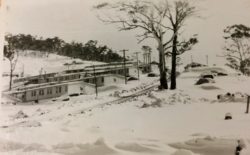


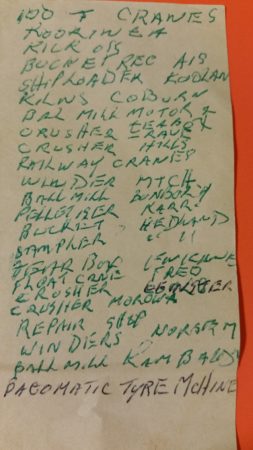
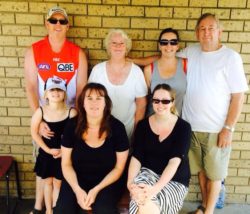
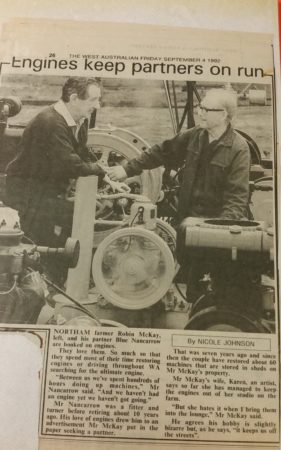
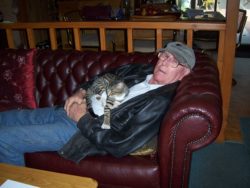
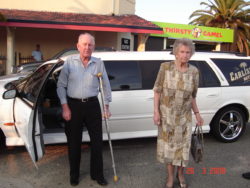
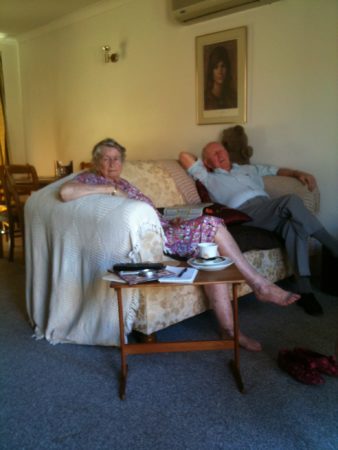

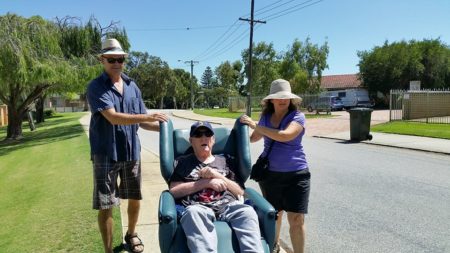



Looking for anyone connected to Bill ( Bluey ) Nancarrow family. I have original black & white photos of Bluey working when he was a Vickers Hoskins.
Thank you, Ray, and we are delighted to have them.
We much appreciate you sending them for the family.